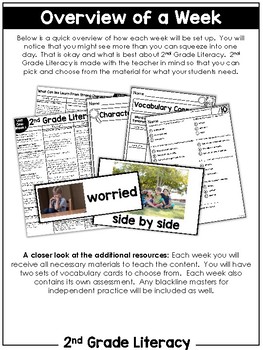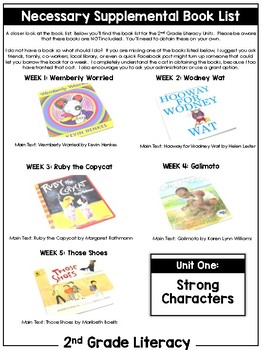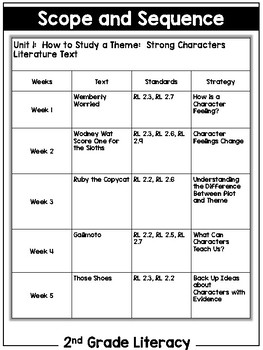2nd Grade Literacy Curriculum Units BUNDLED
- Zip
What educators are saying
Products in this Bundle (6)
showing 1-5 of 6 products
Description
2nd Grade Literacy Units BUNDLED: a comprehensive and complete whole-group literacy curriculum based upon the close read model.
What is 2nd Grade Literacy?
2nd Grade Literacy units are based upon the close read model and is a whole-group reading curriculum. With this program you will not need to supplement another whole-group reading program. Each week you will focus on one text and each day look closely at that text. 2nd Grade Literacy is a 35 week literacy curriculum. The units have been completely planned out for you, but with the ability for you to have them meet your individual needs.
2nd Grade Literacy is a simple print and teach literacy curriculum. No more tracking down ideas, books, printables, and cumulative activities! I have it covered!
What is included in 2nd Grade Literacy?
-Teacher "simple read" lesson plans. You will not need to rewrite these lesson plans, unless you choose do. If so I have included editable lesson plans.
-Each week I have planned out the; big idea, focus standard, essential questions, comprehension focus, story element focus, teaching strategy, vocabulary, and so much more!
-Weekly assessments are included (a mix of multiple choice and short answer)
What are the Units Included in 2nd Grade Literacy?
Wemberly Worried, Wodney Rat, Ruby the Copycat, Galimoto, Those Shoes
Unit Two: Let's Discover the World
From Seed to Plant, Forces Make Things Move, Sounds All Around, Do I Want It or Do I Need It, Bat Loves the Night
Jack and the Beanstalk, Little Red Riding Hood, The Three Little Pigs, Hansel and Gretel, Cinderella
Sitting Bull, The Wright Brothers, Helen Keller, Jackie Robinson, Mae Jemison
David Shannon, Eve Bunting, Mo Willems, Mem Fox, Robert Munsch
Tornadoes, Reptiles, Where Do Chicks From, Robots, Insects
What else will I need for the lessons to be a successful? Can I see more?
Please view the preview to see the scope and sequence of 2nd Grade Literacy Units, necessary books and more!
Tell me more! What is Close Reading?
“Essentially, close reading means reading to uncover layers of meaning that lead to deep comprehension.” (Nancy Boyles, Educational Leadership)
“The overarching goal of close reading is to cause students to engage in critical thinking with a text.” (Dr. Douglas Fisher, Close Reading in Elementary Classrooms)
>>Close, analytic reading stresses engaging with a complex text directly and examining meaning thoroughly and methodically, encouraging students to read and reread with a purpose.
>>By directing students attention to the text itself, we empower students to understand the central ideas and key supporting details.
>>This purposeful reading enables students to reflect on the meanings of words and sentences; the order the sentences unfold; and the development of ideas over the course of the text-which ultimately leads to students to understanding the text as a whole.
As close reading practices are implemented over time, students become better equipped to handle more difficult texts, both in the classroom and independently.
Components of 2nd Grade Literacy Units Close Reading and How it Supports Best Practices:
Determine what the text says: Understanding one’s purpose for reading is a metacognitive process that supports a reader’s comprehension of text. The 2nd Grade Literacy Units close reading structure requires students to apply their sense of purposeful reading in order to locate information in a text. In addition with FirstieLiteracy, teachers can think aloud and model how to read with a purpose by clearly stating the different purposes for them. Before and during reading, students discuss with partners and as a whole group their background knowledge, or schema, about the text topic. FirstieLiteracy provides students with opportunities to develop collaborative conversation skills, integrating text evidence into their discussions. This allows students and teachers to determine their level of knowledge about a topic, which in turn will determine how a reader will read the text. Teachers can help students gain a thorough understanding of the text during the first read by posing low level questions in order to check for understanding and allow students to turn and talk. After the first reading, students should have an understanding of their level of knowledge on the text topic and have a general understanding of what the text is about. Throughout the week of FirstieLiteracy , the text (or parts of the text) will be read more than once, each time with a different purpose for reading.
Reread the text to focus on unknown words or phrases: The second reading of a 2nd Grade Literacy Units text week usually involves a focus on unknown words or phrases within the text. Students listen tentatively as the teacher reads aloud parts of the text, leading a discussion about any unknown words or phrases. Students can engage with unknown vocabulary in a variety of ways, such as: recording words as they hear them (as opposed to the teacher telling them which words are the vocabulary words), working in partners or small groups to determine the meaning of unknown words based on the text, or using the context clues to determine a “kid friendly” definition of the word/s, as well as an “action” to describe the word.
Deepen understanding through Text Dependent Questions: “Text-dependent questions are used in reading instruction to promote the habit of rereading text in order to build schema” (Fisher & Frey, Pearson & Johnson). In FirstieLiteracy , these specific questions cause students to dive deeper into the text and signal to readers the information is complex enough to linger over the details. The text dependent questions move from explicitly stated information (similar to those asked after the first read) to those that require inferential and critical reading. Comprehension deepens at this stage of the lesson, as the basic outline of the text is now understood, allowing students to go back into the text to look for evidence to text dependent questions.
Evaluate the quality and value of the text: The fourth day of 2nd Grade Literacy Units involves comparing the text in a variety of ways. The purpose for reading on this day provides students with opportunities to develop conversation skills, while they integrate evidence from the text into their discussions. The collaboration that takes place on this day allows students to make a claim about the text, provide evidence to support the claim, and offer counter claims-all of which are necessary skills to be college and career ready. Comparisons of the text and author’s purpose can also be done through collaborative projects in which students must work together toward a common goal. Hattie’s research tells us that activities that involve cooperative learning, goal setting, and problem solving all have high effects on student learning. All of these components take place in this close reading structure.
Strive for meaning through a writing prompt or extended discussion with a focus on synthesizing: The final stage of the close reading model involves a post-reading task to demonstrate understanding of the standards and skills taught throughout the close reading lesson. The main focus of this day is to present students with a task that is not completely based on personal experience, but requires them to have read and deeply understood the text in order to complete the task. Students can demonstrate understanding through a written response, project, or discussion. This final task is a way to finalize the learning from the week-students can use their annotations from the text, details from the collaborative discussions they have had throughout the week, as well as feedback they have gotten from the teacher in order to construct a thorough and well constructed response to demonstrate understanding.
Do you teach first grade? I've go you covered with FirstieLiteracy! View HERE!
Do you teach kindergarten? I've go you covered with KinderLiteracy! View HERE!
If you have any questions at all about this packet please email me at littlemindsatworkllc@gmail.com
Visit my blog Little Minds at Work
Follow me on Facebook





